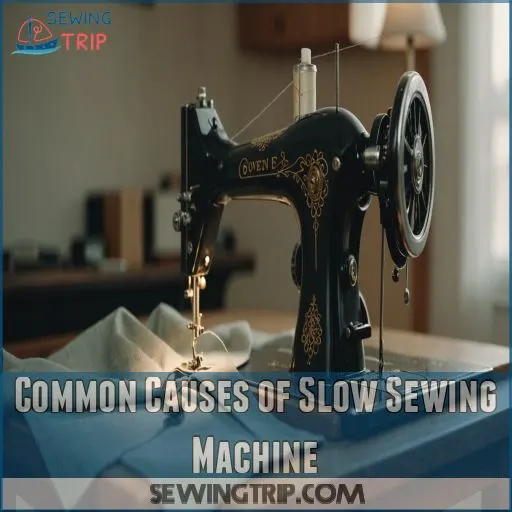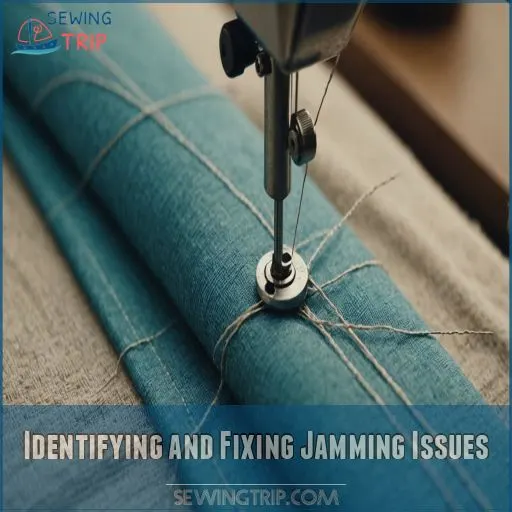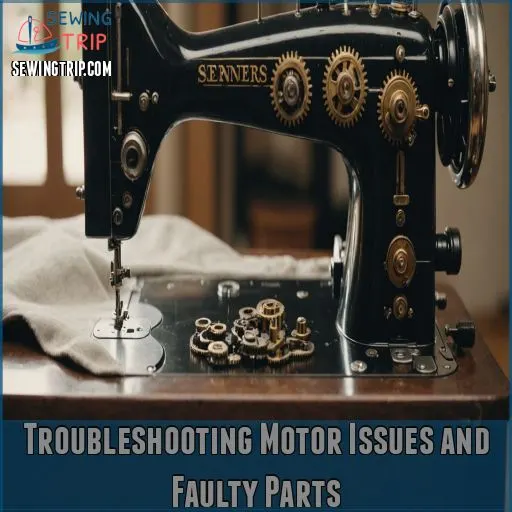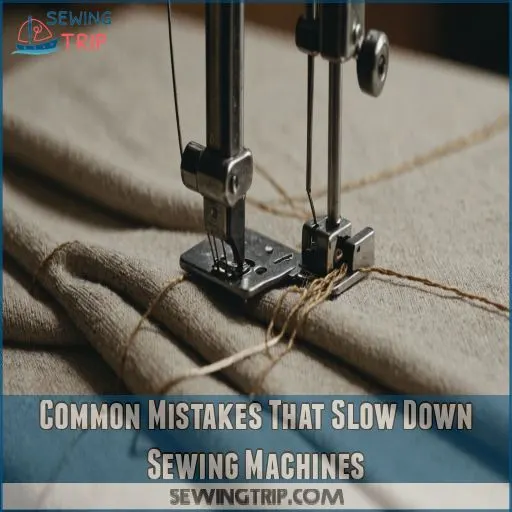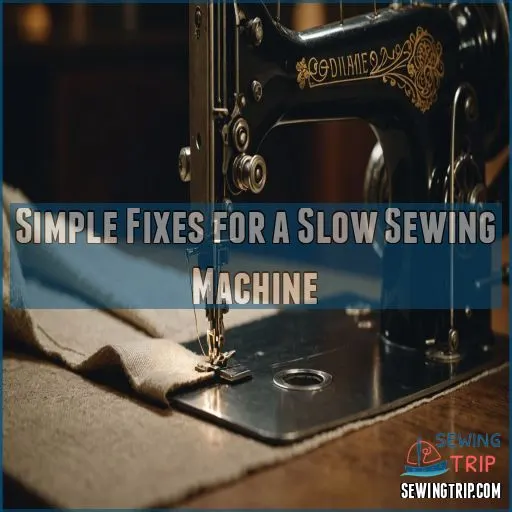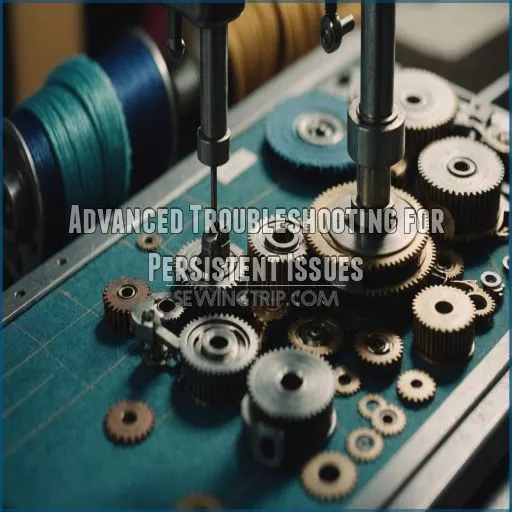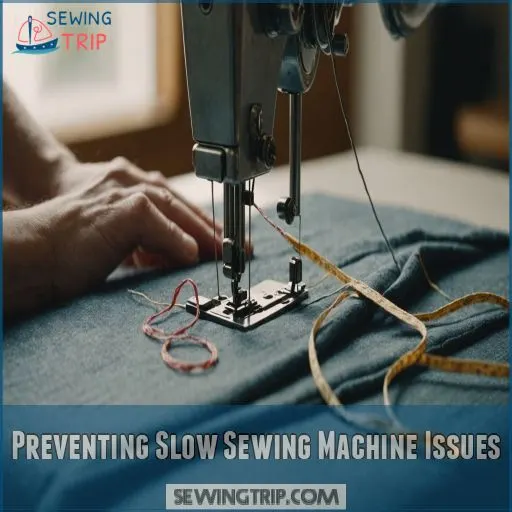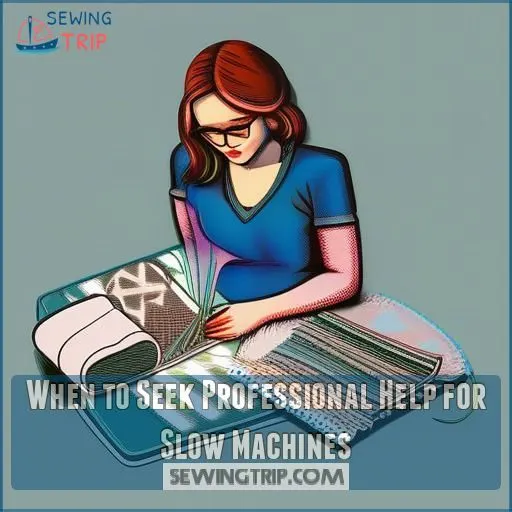This site is supported by our readers. We may earn a commission, at no cost to you, if you purchase through links.
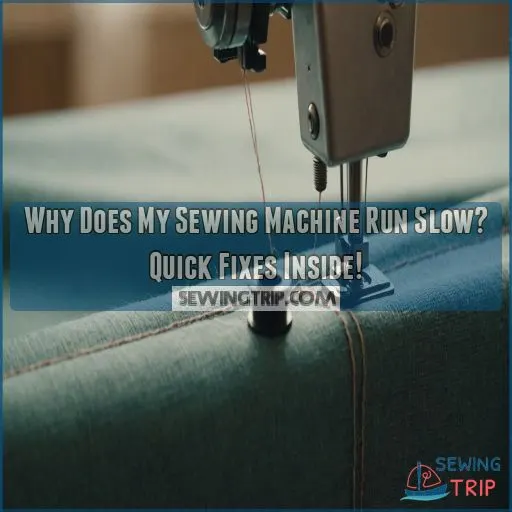
The culprit could be hiding in plain sight. Dirt and lint buildup, lack of lubrication, or even a tangled thread can put the brakes on your stitching speed.
Think of it as your machine’s way of saying, "Hey, I need some TLC!"
Sometimes, it’s as simple as adjusting the speed control or checking for a bent needle. Other times, you might be dealing with motor issues or worn-out parts.
But before you throw in the towel, there are some quick fixes that might get you back to sewing at lightning speed.
Table Of Contents
- Key Takeaways
- Common Causes of Slow Sewing Machine
- Effects of Dirt on Sewing Machine Speed
- Importance of Lubrication in Sewing Machines
- Identifying and Fixing Jamming Issues
- Troubleshooting Motor Issues and Faulty Parts
- Common Mistakes That Slow Down Sewing Machines
- Simple Fixes for a Slow Sewing Machine
- Advanced Troubleshooting for Persistent Issues
- Preventing Slow Sewing Machine Issues
- When to Seek Professional Help for Slow Machines
- Frequently Asked Questions (FAQs)
- Conclusion
Key Takeaways
- Don’t let dust bunnies slow you down! Regular cleaning and lubrication give your sewing machine a refreshing spa day, helping it to purr like a contented cat. Use a small brush to sweep out lint, and oil the moving parts to keep everything running smoothly.
- A tangled thread or a bent needle can turn your machine’s pace from a sprint to a crawl. Double-check your threading path and needle condition to avoid these pesky speed bumps and keep your creative flow uninterrupted.
- If your sewing machine is acting as if it has had one too many coffee breaks, it might be a motor issue. Listen for odd noises or hesitations, and do not hesitate to seek out a technician if things get complicated—no need to wrestle with an uncooperative machine on your own!
- Keep your trusty sidekick in top shape with the right oil and maintenance schedule. Think of oiling as serving a refreshing drink—one suited to your machine’s needs! Remember, a little TLC goes a long way in the land of fabric and stitches.
Common Causes of Slow Sewing Machine
Is your sewing machine running slower than usual?
Don’t worry, there are several common culprits that could be slowing it down, from dirt buildup to motor issues.
Let’s take a closer look and get your machine humming along smoothly again!
Dirt and Debris Buildup
Dust and lint buildup can slow your sewing machine, turning it into a sputtery old car. Regular cleaning is essential to keep it purring smoothly.
- Use a small brush to sweep away dust bunnies.
- Check for tangled thread around moving parts.
- Inspect the drive belt for trapped debris.
- Gently wipe the foot pedal area.
- Conduct a thorough sewing machine cleaning using sewing machine maintenance tips
.
Lack of Lubrication and Oil
Ever feel like your sewing machine’s taking a coffee break in the middle of a project?
A lack of lubrication might be to blame! Regular oiling is key; it keeps parts dancing, not dragging.
Use the right oil types and lubricate frequently.
If you notice signs of dryness, like odd noises or sluggish speeds, grab that oil can pronto!
Jamming and Thread Obstructions
While lack of lubrication can slow your machine, thread jams and obstructions often do the trick too. Common thread jams, bobbin case issues, and incorrect needle thread paths lead to trouble.
In particular, incorrect thread tension, like insufficient tension gauge, and thread misplacement can cause issues. Also, dull or bent needles can contribute to slow sewing machine performance.
To prevent these pesky problems, rethread carefully, check your bobbin winding, and make sure thread tension is spot-on. Remember, a happy sewing machine hums, not halts!
Motor Issues and Faulty Parts
If you’re battling thread tangles and jamming, don’t overlook motor issues.
A sluggish machine might signal worn brushes or faulty parts leading to a slow ride. It’s like a car with a tired engine.
Focus on motor diagnostics and troubleshoot parts. Repairing motors or replacing them could be your ticket back to sewing bliss.
Effects of Dirt on Sewing Machine Speed
When your sewing machine runs slow, it might just be suffering from a dirt invasion, gumming up the works.
Think of it as your machine’s version of a cold—clogged pathways and friction in moving parts make it sluggish, so regular cleaning is like giving it a helpful cleaning!
Friction and Wear on Moving Parts
You know, when your sewing machine’s moving parts get friction wrinkles, it’s like running through molasses. Regular cleaning and lubrication improve function and extend part lifespan.
- Strange noises or grinding sounds
- Uneven stitch formation
- Machine slowing down noticeably
- Worn-out gears or shafts
- Frequent thread breakage
Commit to a cleaning routine and adjust your lubrication frequency for peak performance.
Clogged Thread Paths and Bobbin Area
Clogged thread paths and a dirty bobbin area can really slow down your sewing machine.
Lint, dust, and thread scraps can jam up the works, causing frustrating skipped stitches and tangles.
Give the bobbin case and surrounding areas a thorough brushing to clear out any blockages (Source). A clean machine will sew smoothly and efficiently every time.
Regular Cleaning and Maintenance Tips
So, you’re knee-deep in fabric and your sewing machine’s acting sluggish—a bit like a sleepy cat.
Sure, it could be dust bunnies causing trouble. Grab some cleaning tools and start dusting those nooks and crannies. Think of regular cleaning like giving your machine a spa day.
Remember, a little oil goes a long way in sewing machine care. Follow a sensible frequency guide, ensuring your oil type is spot on, and keep in mind that oil is essential for sewing machine care.
Importance of Lubrication in Sewing Machines
Keeping your sewing machine well-oiled is like giving it a soothing spa day—it reduces friction and keeps everything moving smoothly.
Without proper lubrication, your machine may start sounding like an old haunted house door, sluggishly slowing down your sewing projects.
Reducing Friction and Wear on Parts
Ever felt like your sewing machine’s playing its own slow-motion game? Reducing friction can work wonders.
To keep your machine zipping along smoothly, remember:
- Regularly clean and oil the moving parts to reduce wear.
- Check the belt tension to make sure it has a good grip and works efficiently.
- Clear any thread or lint build-up from the bobbin area.
- Make sure the thread quality is good to avoid unnecessary snags.
A little TLC keeps your machine humming happily!
Choosing the Right Type of Oil
Choosing the right sewing machine oil is like finding the perfect dance partner—smooth, reliable, and always in step. Consider oil viscosity, consistency, and application to keep things running seamlessly.
| Feature | Importance | Example Brands |
|---|---|---|
| Viscosity | Impacts flow and lubrication efficiency | Liberty Oil |
| Consistency | Affects absorption and non-gumming properties | Juki Oil |
| Application | Ease of accessing hard-to-reach machine areas | Sewable Premium |
Stick to sewing-specific oils, avoiding general multi-purpose types!
Frequency of Oiling Based on Usage
You’re up to speed on sewing machine oil types, now let’s chat about an oiling schedule that’ll keep your machine purring like a kitten. Depending on usage, remember that a well-oiled machine runs smoothly and quietly, reducing the need for proper machine lubrication.
Oiling quarterly is enough for most models, but heavy users may need to oil monthly.
- Oil the hook area every three to four bobbin changes.
- For intense sewing, add a few drops every couple of hours.
- Light daily use? Once a day or every two days is solid.
- Remember, cleanliness helps performance too!
Identifying and Fixing Jamming Issues
Ever feel like your sewing machine’s got a mind of its own, running slower than a Monday morning?
Fear not, because tackling thread jams is like untangling a necklace, frustrating yet oddly satisfying once those pesky knots are gone!
Common Areas Prone to Jamming
Sewing machines can jam up in a few pesky spots. Check the thread path, bobbin case, and needle plate – these are prime real estate for stray threads and lint to accumulate.
The feed dogs under the presser foot may also get clogged, restricting fabric movement.
| Area | Issue |
|---|---|
| Thread Path | Tangled threads |
| Bobbin Case | Lint buildup |
| Needle Plate | Fabric scraps |
| Feed Dogs | Restricted movement |
Carefully inspect each area and clear out any debris using tweezers or a soft brush. This should get your machine humming along smoothly again.
Removing Thread and Debris
Let’s tackle a slow sewing machine by cleaning it thoroughly.
Start by removing the needle plate and bobbin case. Use a brush or tweezers to clear out lint and stray threads—it’s like your machine’s version of a spa day!
Don’t forget to check the thread path and make sure it’s clear.
A clean machine runs smoothly, like a well-oiled sewing symphony.
Re-threading and Re-spalling the Machine
Ever had tangled threads slow your roll? It’s like driving with a flat tire—frustrating and slow.
First, make sure the thread path is clear and spool type matches.
Check bobbin tension; if it’s too tight, chaos ensues. A mismatched needle size can throw everything off balance.
Different machine types may need unique tweaks, so consult your manual for re-threading tips.
Stay calm, stitch on!
Troubleshooting Motor Issues and Faulty Parts
If your sewing machine’s slowing to a crawl, the motor might be misbehaving or in need of a check-up.
Don’t worry—sometimes it’s just a stubborn pedal or a rebellious needle adding a bit of drama to your crafting!
Verifying Motor Function and Speed
Curious if your sewing machine’s motor is up to speed? Give it a whirl by performing a motor speed test.
If it hesitates, it might be time to check the foot pedal connections or notice unusual motor noise .
Keep an ear out for odd sounds—like a cat trying to sing opera!—because they can signal deeper issues, needing more than just pedal adjustments.
Replacing or Servicing the Motor
When your sewing machine’s motor seems to drag its feet, it’s time to look into replacing or servicing it.
Stuck with speed issues? Consider these options:
- DIY motor fix: Try it if you’re handy and brave.
- Motor repair options: Seek affordable local technicians.
- Motor brand comparison: Find one that’s worth every penny.
- Motor lifespan: Are you dealing with a dinosaur?
Don’t let a slowpoke motor sew down your creativity!
Checking for Bent or Broken Needles
Is your sewing machine feeling sluggish? Take a closer look at the needle—it might be the culprit.
A bent or broken needle can wreak havoc, slowing your sewing like a traffic jam on a Monday morning. Swap it out regularly to prevent mishaps.
Remember, needles aren’t forever! Use different needle types depending on your fabric, and avoid unbecoming needle damage for smooth, trouble-free stitching. This will ensure that your stitches are smooth, trouble-free, and you can focus on more creative endeavors.
The importance of using the right needle type cannot be overstated, as it directly affects the quality of your stitches. By taking the time to choose the correct needle, you can avoid unbecoming needle damage and create beautiful, professional-looking stitches.
Common Mistakes That Slow Down Sewing Machines
Are you accidentally using the wrong presser foot or not pressing the foot pedal all the way down?
Oops, looks like you may have the bobbin winder engaged or the stitch length set too short – no wonder your machine is running slow!
Let’s take a closer look at these common mistakes and get your sewing back on track.
Incorrect Presser Foot and Foot Pedal Use
If your sewing machine’s going slower than a snail in traffic, it might be due to incorrect presser foot or foot pedal use.
- Presser Foot Types: Use the right one for your fabric.
- Foot Pedal Pressure: Press gently for smooth speed control, but firm enough to get things moving.
- Pedal Adjustments: Check if it’s connected properly and functioning well.
Stitch Length and Bobbin Winder Settings
Now, let’s chat about stitch length and bobbin winder settings. Imagine trying to run with shoelaces tied together—frustrating, right? Well, a short stitch length slows your machine like molasses. Adjusting the stitch length can kiss your sewing speed demons goodbye. Similarly, a tangled bobbin can wind you up! Check your bobbin winding speed to avoid tension issues or fabric frustrations.
Adjusting the stitch length can affect your sewing speed. A short stitch length can slow down your machine.
Make sure your bobbin winding is smooth to avoid tension issues.
| Setting | Impact | Solution |
|---|---|---|
| Stitch Length | Speed control | Adjust to 3 or 4 |
| Bobbin Winder | Thread tension | Make sure winding is smooth |
| Needle Size | Fabric type | Match for best results |
| Fabric Type | Stitch quality | Choose settings wisely |
| Tension | Seam stability | Fine-tune as needed |
Power Cord and Electrical Issues
Don’t let power cord issues make your sewing machine run slower than a tired snail. First, check for cord damage—it might look like it joined a circus and a pretzel.
Test the outlet; sometimes it’s a power surge party. Troubleshoot these before blaming the foot pedal:
- Cord damage
- Outlet problems
- Foot pedal issues
- Power surge
Stay safe and avoid electrical shock while you’re at it!
Simple Fixes for a Slow Sewing Machine
When your sewing machine feels more like a leisurely stroll than a quick sprint,
a few simple tweaks can help it pick up the pace.
Dust it off, check the thread path, and make sure everything’s sliding smoothly—
your machine will thank you by purring like new with a purring like new sound.
Adjusting Speed Control and Stitch Length
Got that sewing machine lagging behind on speed and stitch length? Let’s chat about fixing it up. Adjusting speed control settings and stitch length isn’t rocket science.
Think of it as your sewing machine’s sweet spot for different fabric or project types. Here’s a quick look:
| Speed Control | Stitch Length Impact |
|---|---|
| Slow Speed | Uneven Stitches |
| Medium Speed | Balanced Stitches |
| Fast Speed | Skipped Stitches |
| Super Fast | Thread Breaks |
See how setting it right makes all the difference? Keep it steady!
Cleaning and Lubricating the Machine
Neglect is the nemesis of your sewing machine’s speed.
To keep it humming along, regular cleaning and lubrication are essential.
Grab your cleaning tools and give your machine a good once-over, focusing on the bobbin area and moving parts.
Apply a few drops of sewing machine oil to the designated spots – your manual will be your best guide here.
Remember, a well-oiled machine is a happy machine, just like your car!
Checking for Lint and Debris Buildup
Over time, your sewing machine can become a lint magnet, slowing it down like molasses in January.
To keep it purring along, grab your cleaning supplies and focus on common trouble spots.
The shuttle race and feed dogs need a thorough once-over every few months, or more if you’re a frequent stitcher.
Don’t forget to oil up after cleaning – it’s like giving your machine a good tune-up after a workout!
Advanced Troubleshooting for Persistent Issues
If your sewing machine’s still crawling despite basic fixes, it’s time to roll up your sleeves for some advanced troubleshooting.
We’ll tackle persistent slowdowns by examining your machine’s inner workings, from belt tension to electrical quirks, so you can get back to stitching at full speed.
Inspecting the Belt and Drive System
After tackling those simple fixes, it’s time to dig deeper.
Your sewing machine’s belt and drive system could be the culprits behind that sluggish performance.
Check if the belt’s on tight and turning freely (Source). A loose or worn belt can make your machine crawl like a tortoise in a marathon.
Look for signs of belt slippage or wear, and make sure the pulleys are aligned properly.
If you spot issues, it might be time for a belt replacement.
Adjusting Thread Tension and Presser Foot Pressure
If your sewing machine’s still running slow, it’s time to fine-tune your thread tension and presser foot pressure. These adjustments can make a world of difference in your stitching speed and quality.
- Check your thread tension dial – it should be set to match your fabric weight
- Adjust presser foot pressure for smooth fabric feed
- Test stitch on scrap fabric to make sure tension is balanced
- Fine-tune settings until you achieve even stitches without puckering
Checking for Electrical Cord and Foot Pedal Issues
Frustration with a slow sewing machine can unravel your patience. When advanced troubleshooting is needed, don’t overlook electrical components.
Check your cord and foot pedal for issues that might be putting the brakes on your stitching speed.
| Issue | Symptoms | Quick Fix |
|---|---|---|
| Cord damage | Intermittent power | Replace cord |
| Loose connections | Inconsistent speed | Tighten connections |
| Foot pedal wear | Unresponsive pedal | Clean or replace pedal |
| Power fluctuations | Varying speeds | Check outlet |
| Internal wiring | Erratic behavior | Professional service |
Remember, a healthy electrical system is key to keeping your sewing machine humming along smoothly.
Preventing Slow Sewing Machine Issues
Keeping your sewing machine running smoothly isn’t just about fixing problems when they arise – it’s about preventing them in the first place by maintaining consistent thread tension sewing machine maintenance
.
With a few simple habits and the right know-how, you can say goodbye to those frustrating slow-downs and keep your trusty machine humming along at top speed.
Regular Maintenance and Cleaning Schedule
Establish a regular maintenance routine to keep your sewing machine purring like a contented cat. You’ll prevent those frustrating slow-downs and extend your machine’s life.
- Clean after every 8-10 hours of sewing
- Lubricate moving parts monthly
- Perform a deep clean quarterly
Remember, a well-maintained machine is a happy machine! Think of it as giving your trusty sidekick a spa day. Your future self will thank you when you’re zipping through projects without a hitch.
Choosing the Right Sewing Machine Oil
You’ve cleaned your machine, but now it’s time to give it a drink!
Choosing the right sewing machine oil is like picking the perfect smoothie for your mechanical friend. Look for clear, non-staining oil with the right viscosity.
Brands like Singer, Liberty, and Zoom-SPOUT offer great options. Remember, a little goes a long way – apply sparingly to keep your machine purring like a well-oiled kitten.
Your fabric will thank you for the smooth, stain-free stitches, and the machine will run smoothly, like a well-oiled kitten.
Avoiding Common Mistakes and Errors
Now that you’ve mastered oil selection, let’s tackle common sewing pitfalls.
Choosing the wrong needle can lead to bent or broken needles, slowing your machine . Always match your needle to your fabric type.
Keep an eye on your presser foot pressure too – too little or too much can cause uneven feeding .
And don’t forget to lower that presser foot before you start sewing! It’s a rookie mistake we’ve all made at least once.
When to Seek Professional Help for Slow Machines
While most sewing machine issues can be resolved at home, sometimes you need to call in the pros.
If you’ve tried all the DIY fixes and your machine’s still running slower than a turtle in molasses, it might be time to seek help from a qualified technician who can diagnose and repair more complex problems.
Signs of Major Issues or Damage
While regular maintenance keeps your sewing machine humming, sometimes it needs professional TLC. Watch for these red flags:
- Unusual noises like grinding or rattling
- Excessive vibration or wobbling
- Visible oil leaks or burning smells
- Consistent stitch issues despite adjustments
These could signal internal damage or worn parts. Remember, a well-maintained machine is like a happy cat – purring smoothly.
If yours sounds more like an angry badger, it’s time to call in the experts. Don’t let a cranky machine ruin your sewing mojo!
Finding a Qualified Sewing Machine Technician
When your sewing machine’s snail-like pace persists, it’s time to call in the cavalry.
Finding a qualified technician isn’t just about flipping through the yellow pages. Look for local pros with glowing online reviews and a track record of happy customers (Source).
Don’t shy away from asking about their experience with your specific machine model. A good technician should offer a clear estimate and explain potential issues without overwhelming you with jargon.
Repair or Replacement Options for Slow Machines
Ever wondered if it’s time to bid farewell to your trusty old sewing machine?
When repair costs start rivaling the price of a new model, it’s decision time. Consider DIY solutions first, but don’t hesitate to call in the pros for complex issues.
Check your warranty options before shelling out cash.
If replacement’s on the horizon, shop around for gently used machines or consult local technicians for recommendations. Remember, sometimes a fresh start is just what your sewing projects need, or it might be time to call in the local technicians.
Frequently Asked Questions (FAQs)
Why does my sewing machine run slow?
Your sewing machine’s sluggish pace could be due to several factors.
Lack of lubrication, lint buildup, or a worn drive belt are common culprits.
Regular maintenance, including oiling and cleaning, can help keep your machine running smoothly.
Why does my sewing machine keep going up and down?
The needle’s constant up-and-down motion might be due to an engaged bobbin winder.
Check if you’ve accidentally left it on after winding a bobbin.
This can prevent proper needle positioning and cause threading issues .
What happens if a sewing machine goes too fast?
Sewing too fast can create unreliable stitches, damage fabric, and stress your machine.
You’ll lose control, potentially ruining your project.
It’s like driving a car – slow and steady wins the race, especially in terms of quality craftsmanship.
Can a slow running sewing machine be repaired?
Yes, slow-running machines can often be repaired.
Lubricating moving parts, adjusting belt tension, and checking electrical components can revive sluggish performance.
Don’t let a slow machine unravel your sewing dreams – with some TLC, you’ll be stitching at full speed soon!
How to fix a slow sewing machine?
Don’t let a sluggish sewing machine needle you!
First, clean and oil your trusty sidekick .
Then, check the belt tension and lubrication.
If it’s still dragging, inspect the motor and electrical components for wear.
Why is the machine running slowly?
Your machine’s sluggish performance could stem from various issues.
Lack of lubrication, lint buildup, a worn drive belt, or a faulty motor are common culprits.
Regular cleaning and oiling can work wonders, like giving your trusty machine a spa day!
How can I make my sewing machine faster?
Like a car shifting gears, you can rev up your sewing machine’s speed.
Adjust the speed controller, pressing harder on the foot pedal for more zip .
For a turbo boost, consider upgrading to a servo motor.
What controls the speed of a sewing machine?
The speed of a sewing machine is controlled by a foot pedal containing resistors and switches.
As you press down, it shorts more resistors, allowing more current to reach the motor, increasing speed.
It’s like a car’s accelerator!
Can fabric choice affect sewing machine speed?
Threading through the fabric jungle, your sewing machine’s speed can vary wildly.
Heavier fabrics like upholstery might require a slower pace and longer stitches, while lighter cottons let you zip along.
It’s all about finding the right tension balance.
Your sewing machine’s speed can be influenced by the type of fabric being used, with heavier fabrics requiring a slower pace.
Does the age of my sewing machine matter?
Older sewing machines might lack adjustable speed settings or modern motors, potentially leading to slower performance.
However, with proper maintenance and adjustments, you can keep them humming along just fine, like a trusty old car .
They have proper maintenance in common, which is essential to keep old sewing machines running well.
How does thread tension impact sewing speed?
Imagine your sewing machine is a sports car – the thread tension is like the proper thread gauge
.
If it’s too tight, the engine (your machine) will sputter and slow down.
Loosen that tension, and you’ll be zipping along in no time!
Can incorrect needle size slow down stitching?
Choosing the wrong needle size can make your sewing machine feel sluggish as a snail in molasses, especially when working with a clogged needle plate cover
.
Needles too large or small create resistance, causing slower stitching.
Match your needle size to fabric and thread weight.
Does using a servo affect sewing speed?
A sewing machine with a servo motor is like a well-trained horse; it provides excellent control at various speeds.
It offers precise speed management, often requiring a speed reducer for ultra-slow settings.
Conclusion
Think of your sewing machine as the car that won’t start when it runs slow; it’s time to investigate!
Address those possible culprits like dirt, lack of oil, or tangled threads, and you’ll likely solve the mystery of "why does my sewing machine run slow."
Embrace some hands-on TLC: clean, oil, and troubleshoot common issues.
If persistent problems arise, don’t fret; a trusty technician’s just a call away.
Keep stitching bright and running smoothly!

